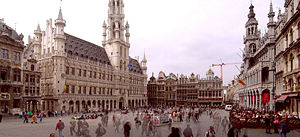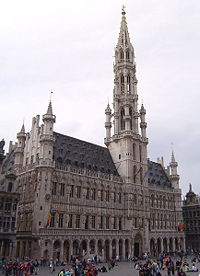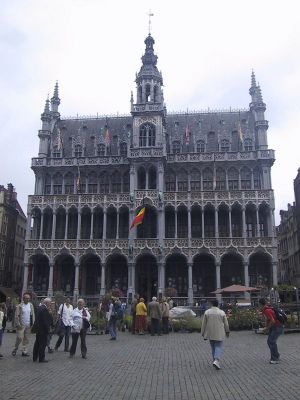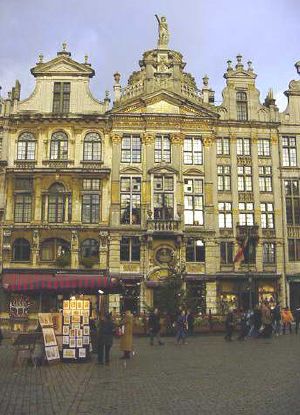Difference between revisions of "Grand Place" - New World Encyclopedia
David Doose (talk | contribs) m |
David Doose (talk | contribs) m |
||
| Line 12: | Line 12: | ||
| Link = http://whc.unesco.org/en/list/857 | | Link = http://whc.unesco.org/en/list/857 | ||
}} | }} | ||
| − | The '''Grote Markt''' ([[Dutch language|Dutch]]) or '''Grand Place''' ([[French language|French]]) is the central market square of [[Brussels]]. It is surrounded by [[guild]] houses, [[Brussels Town Hall|the city's Town Hall]] and the Bread House. The square is considered to be one of the most beautiful town squares in [[Europe | + | The '''Grote Markt''' ([[Dutch language|Dutch]]) or '''Grand Place''' ([[French language|French]]) is the central market square of [[Brussels]]. It is surrounded by [[guild]] houses, [[Brussels Town Hall|the city's Town Hall]] and the Bread House. The square is considered to be one of the most beautiful town squares in [[Europe]]. |
==History== | ==History== | ||
| Line 35: | Line 35: | ||
*The square is a pilgrimage site for fans of the cult [[BBC]] television series ''[[Secret Army (TV series)|Secret Army]]'', the second and third series of which were filmed here in 1978 and 1979, specifically around the building that is now [[Maxim's]] restaurant. | *The square is a pilgrimage site for fans of the cult [[BBC]] television series ''[[Secret Army (TV series)|Secret Army]]'', the second and third series of which were filmed here in 1978 and 1979, specifically around the building that is now [[Maxim's]] restaurant. | ||
==Town Hall== | ==Town Hall== | ||
| − | The construction of the building represents the growing power of Brussels as the capital of the Dukedom of Brabant. Until the end of the 14th century some small wooden houses and inns used to stand on the site where later the town hall would be | + | The construction of the building represents the growing power of Brussels as the capital of the Dukedom of Brabant. Until the end of the 14th century some small wooden houses and inns used to stand on the site where later the town hall would be built. Because of the growing importance of the city, the administrators decided to buy these old houses one by one, demolish them and build a new town hall that would match the city's need for a large administrative center. |
| − | The | + | The first stone was laid in the spring of 1402. This original town hall (which is now the left wing) was completed in 1405, together with a small tower. The architect is believed to be [[Jacob Van Tthienen]]. However, on March 3, 1444, the original building was extended with a smaller right wing, which was ready in 1449. In that same year the architect [[Jan Van Ruysbroeck]] built the tower that still crowns the building today. This extension of the town hall was a result of the rivalry between Brussels and the neighboring city of Leuven. Leuven also aspired to the title of ''capital of the Dukedom of Brabant'' and had therefore also constructed a massive and extremely prestigious town hall. |
| − | After the destruction of Brussels in August 1695 by the French troops of | + | Finally, in 1455 a guilded [[statue]] of [[St. Michael]] slaying the [[devil]] was put on top of the town hall tower. The original statue remained on the tower until June 1996, when it was replaced with a completely new one (after 541 years!). When facing the town hall most people remark immediately that the tower is standing in the middle of the building. Legend has it that the architect committed suicide by throwing himself of the tower when he noticed that the tower was not in the middle. Like most other legends surrounding the monuments of Brussels, this one also is not true. The tower not being in the middle is simply the result of the fact that the right wing of the town hall could not be made as large as the left wing because the town authorities wanted to preserve the street next to the right wing. |
| + | |||
| + | After the destruction of Brussels in August 1695 by the French troops of De Villeroy, only the tower and the outside walls of the town hall had been saved. Restoration works started almost immediately after the catastrophe. In the 17th and 18th centuries the original decorative statues withered away or disappeared. By 1840 a complete restoration was necessary. It was then that the entire facade became decorated with a total of 203 little statues representing the Dukes and Duchesses of Brabant, who ruled the dukedom between the year 580 and 1564. | ||
The town hall is still the seat of the Mayor of Brussels . The city administration is located elsewhere, on Boulevard Anspach.<ref>[http://www.trabel.com/brussel/brussels-town_hall.htm]</ref> | The town hall is still the seat of the Mayor of Brussels . The city administration is located elsewhere, on Boulevard Anspach.<ref>[http://www.trabel.com/brussel/brussels-town_hall.htm]</ref> | ||
Revision as of 02:59, 29 May 2008
| Grand-Place, Brussels* | |
|---|---|
| UNESCO World Heritage Site | |

| |
| State Party | |
| Type | Cultural |
| Criteria | ii, iv |
| Reference | 857 |
| Region** | Europe and North America |
| Inscription history | |
| Inscription | 1998 (22nd Session) |
| * Name as inscribed on World Heritage List. ** Region as classified by UNESCO. | |
The Grote Markt (Dutch) or Grand Place (French) is the central market square of Brussels. It is surrounded by guild houses, the city's Town Hall and the Bread House. The square is considered to be one of the most beautiful town squares in Europe.
History
The Town Hall was constructed between 1402 and 1455. The original architect was probably Jacob van Thienen. The gothic tower was designed by architect Jan van Ruysbroeck. At the top of the 97 meter (318 feet) tower stands a statue of St. Michael, the patron of Brussels.
In the 13th century the predecessor of the Bread House was a wooden building where bakers sold their bread in a covered market. Its Dutch name Broodhuis recalls this function. It was replaced in the 15th century by a stone building for the administration of the duke of Brabant. When the duchy fell to the Habsburgs, the Maison du Duc (Duke's house) became the Maison du Roi (King's house), the latter being the current French name of the building. Charles V rebuilt the building in a late Gothic style during his reign in the 16th century, similar to its appearance today. In 1873, the city entrusted architect Victor Jamaer to restore the battered structure in neo-gothic style.
The Grand Place was first laid out after the construction of the town hall, at the centre of the city's commercial district. Neighboring streets still reflect the area's origins, named after the sellers of butter, cheese, herring, coal and so on. The original Grand Place was a medley of buildings constructed between the 15th and 17th centuries in a variety of styles.
On August 13, 1695, a 70,000-strong French army under Marshal François de Neufville, Duke of Villeroy began a bombardment of Brussels in an effort to draw the League of Augsburg's forces away from their siege on French-held Namur in what is now southern Belgium. The French launched a massive bombardment of the mostly defenseless city centre with cannons and mortars, setting it on fire and flattening the majority of the Grand Place and the surrounding city. Only the stone shell of the town hall and a few fragments of other buildings remained standing. That the town hall survived at all is ironic, as it was the principal target of the artillery fire.
The square was rebuilt in the following four years by the city's guilds. Their efforts were regulated by the city councilors and the Governor of Brussels, who required that their plans be submitted to the authorities for their approval. This helped to deliver a remarkably harmonious layout for the rebuilt Grand Place, despite the ostensibly clashing combination of Gothic, Baroque and Louis XIV styles.
Pageant
On the first Thursday in July, Grand Place is the site of the Omegang pageant. Over 2,000 costumed participants parade past the king of Belgium. The event dates from 1549, when it was first presented to King Charles V.
Trivia
- The Grand Place was named by UNESCO as a World Heritage Site in 1998. One of the houses was owned by the brewers' guild, and is now the home of a brewers' museum.
- The square is a pilgrimage site for fans of the cult BBC television series Secret Army, the second and third series of which were filmed here in 1978 and 1979, specifically around the building that is now Maxim's restaurant.
Town Hall
The construction of the building represents the growing power of Brussels as the capital of the Dukedom of Brabant. Until the end of the 14th century some small wooden houses and inns used to stand on the site where later the town hall would be built. Because of the growing importance of the city, the administrators decided to buy these old houses one by one, demolish them and build a new town hall that would match the city's need for a large administrative center.
The first stone was laid in the spring of 1402. This original town hall (which is now the left wing) was completed in 1405, together with a small tower. The architect is believed to be Jacob Van Tthienen. However, on March 3, 1444, the original building was extended with a smaller right wing, which was ready in 1449. In that same year the architect Jan Van Ruysbroeck built the tower that still crowns the building today. This extension of the town hall was a result of the rivalry between Brussels and the neighboring city of Leuven. Leuven also aspired to the title of capital of the Dukedom of Brabant and had therefore also constructed a massive and extremely prestigious town hall.
Finally, in 1455 a guilded statue of St. Michael slaying the devil was put on top of the town hall tower. The original statue remained on the tower until June 1996, when it was replaced with a completely new one (after 541 years!). When facing the town hall most people remark immediately that the tower is standing in the middle of the building. Legend has it that the architect committed suicide by throwing himself of the tower when he noticed that the tower was not in the middle. Like most other legends surrounding the monuments of Brussels, this one also is not true. The tower not being in the middle is simply the result of the fact that the right wing of the town hall could not be made as large as the left wing because the town authorities wanted to preserve the street next to the right wing.
After the destruction of Brussels in August 1695 by the French troops of De Villeroy, only the tower and the outside walls of the town hall had been saved. Restoration works started almost immediately after the catastrophe. In the 17th and 18th centuries the original decorative statues withered away or disappeared. By 1840 a complete restoration was necessary. It was then that the entire facade became decorated with a total of 203 little statues representing the Dukes and Duchesses of Brabant, who ruled the dukedom between the year 580 and 1564.
The town hall is still the seat of the Mayor of Brussels . The city administration is located elsewhere, on Boulevard Anspach.[1]
Notes
ReferencesISBN links support NWE through referral fees
- Goedleven, Edgard. 1993. The Grand Place in Brussels: centre of five hundred years of history. [Brussels]: Lannoo Publishers. ISBN 9020923145
External links
- World Heritage Site - Unesco,org.
- The Grand Place in Brussels - Belgium.be.
- Brussels Travel and Tourist Information Guide Brusselscitytourist.com.
- 360° panoramic view of "Grand Place from Brussels" -Visitonweb.com.
- Virtual visit, photos and webcam of the Grand Place. Retrieved May 4, 2008.
- Brussels - Brusselscreativity.com.
- Grand Place - Glasssteelandstone.com.
| |||||||
Credits
New World Encyclopedia writers and editors rewrote and completed the Wikipedia article in accordance with New World Encyclopedia standards. This article abides by terms of the Creative Commons CC-by-sa 3.0 License (CC-by-sa), which may be used and disseminated with proper attribution. Credit is due under the terms of this license that can reference both the New World Encyclopedia contributors and the selfless volunteer contributors of the Wikimedia Foundation. To cite this article click here for a list of acceptable citing formats.The history of earlier contributions by wikipedians is accessible to researchers here:
The history of this article since it was imported to New World Encyclopedia:
Note: Some restrictions may apply to use of individual images which are separately licensed.


